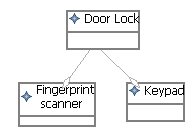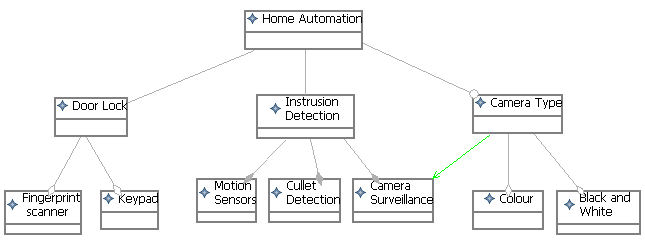|
Purpose
The purpose of this task is modeling the defined SPL scope, so it is the first task of
interpreting and ordering the requirements. Its main inputs are the Product Map and Row DRS (from the
elicitation).
|
Relationships
| Roles | Primary Performer:
| Additional Performers:
|
| Inputs | Mandatory:
| Optional:
|
| Outputs |
|
Main Description
This scope is modeled using features, which are externally visible characteristics of
products in a domain Lee et al. (2002) and represent an abstraction
from requirements Gurp et al. (2001). In particular, features are
characteristics that are used to differentiate among members of a SPL and hence to determine and define its common and
variable functionalities Gomaa (2005).
Feature modeling captures and represents commonalities and variabilities of the
features in a model, so this information may help developers to identify which parts of their system need to support
variability. This modeling is based on FODA Lee et al. (2002), in which the features are
organized into a AND/OR hierarchy diagram that captures structural or conceptual relationships among features.
According to Sinnema et al. (2004), this hierarchical organization of variability
representation reduces the cognitive complexity that these large numbers impose on engineers that deal with variation
points.
This task is part of the activity Model Scope. Folowwing Figure shows an overview of this activity. Scoping and Model Scope may have to be performed in
parallel or iteratively until the scope becomes complete, at which time detailed feature modeling may start. When new
features are identified in Model Scope, the Scoping needs approve the inclusion of this new feature in SPL. Thus, a
change request must be submitted to EM, and EM performs communication with Scoping. Whether a feature is updated in the
scope, it also must be updated in the feature model.
|
Steps
|
Identify
There are some doubts about the abstraction level of features modeling. Some
questions are often identified, such as “To what extent it is worth refine a feature which has many specific sub-features?”. Thus, this work presents
the following guidelines to help to identify features and avoid those
doubts.
-
In feature model must be represented features that reflect value and
competitively for organizations launch product quicker. Thus, it is necessary representing features more
relevant and that present a differential among products. Some variations are irrelevant to represent in feature
model, since they do not represent decisions with differential. For example, it does not represent variations
in level attributes with low technical impact. Other situations of irrelevance must be observed by the analyst.
A typical situation is when can be necessary represent several reports in a SPL. However, the reports amount
can become the feature model in a complex model with many non-relevant features. In this case, the solution can
be creating categories that group reports more relevant and that add a differential among products (e.g. quality reports, managerial reports and financier reports).
-
Features can be refined into sub features. It must be performed to represent
relevant variantions in a level more detailed. The sub features are identified during the feature model
representation, which will be seen in the next section.
-
It does not identify all implementation details that do not distinguish
products in a domain. A skillful developer tends to enumerate all the implementation details and identify them
as features, even though there are no variations among them. It is necessary remember that a feature model is
not a requirement model, which expresses the details of internal functions. The modeling focus should be on
identifying properties, factors, assumptions that can differentiate one product from other in the same domain,
not on finding all implementation details that are necessary to implement the products in a domain Lee et
al. (2002).
-
Attached features that always exist together can be group in a single feature.
For example, the User feature always exists in presence of the Login/Logout feature, so it can be yet grouped
into Authentication feature. However, some constraints must be observed for the features grouping:
-
Whether there are dependency constraints (e.g. implication or
exclusion) in a part of a grouped feature, it is necessary ungroup the feature part with distinct
constraints.
-
Whether there are distinct variabilities types among grouped features
(i.e. a part is optional and another is feature) it is necessary ungroup the features.
-
Optional features that are always used together can be packaged into
optional feature.
-
Related features that are required by all members of the SPL are
packaged into mandatory features.
-
A grouped feature must define in its description the other grouped
features.
Another way to identify news features is by feature model representation.
|
Represent
Features are modeled in terms of the following relationships:
-
Composed-of. This relationship is used if there is a whole-part relationship between a feature
and its sub-features (parent-role: whole, child-role: part);
-
Generalization/specialization. In
cases where features are generalization of sub-features, they are organized using the generalization/
specialization relationship (parent-role: general-entity, child-role: specialized-entity). Two or more features
with similar functionalities can be generalized into one feature by abstracting the differences into
variability through feature generalization. It is possible to define feature in more general fashion which
helps to identify a common functionality among products;
-
Implemented-by. The implemented-by
relationship is used when a feature (i.e. a feature of an implementation technique) is necessary to implement
the other feature;
-
Dependency. This relationship
represents dependency constraints of implication (require) or exclusion. It is used to constrain the
selection from variant features. That is, it is possible to specify which features should be selected along
with a designated one and which features should not. In this relationship, a mandatory feature does not can
depend of another, but a variant feature can depend of a mandatory feature.
The features model does not must represent functional dependencies, like a function
call hierarchy, but organize features to capture and represent commonalities and differences Lee et al.
(2002). Feature model must represent relationships between features that impact in decision making
in the products scope.
In the feature model, there are concrete and conceptual features. A concrete feature
represents a real feature in the SPL scope. The conceptual feature is used only to help in the model organization. It
really is not represented in the SPL scope. For example, the feature at the root of the tree is called root feature and
it is usually a conceptual feature that represents the whole system. Another example is in the generalization
relationship, in which the general-entity is normally a conceptual feature. For composed-of relationship, the parent
and child features are usually concrete.
A key feature in the feature model is the Variation Point (VP). VP represents a
variability subject and it is composed by variability objects (options of the VP) Pohl et al.
(2005). An example of the VP is shown in following Figure. This VP is part of a SPL example in the home automation domain used in Pohl et al.
(2005). It represents that the “Door Lock” VP has the options “Fingerprint scanner” and
“Keypad”.

The commonality and variability representation is defined by the feature types and are
given as follows:
-
Mandatory. Common feature
among all products, i.e. it always should be selected by the products of the SPL.
-
Optional. One feature may or may not be selected for a product.
-
Alternative. This feature
type is applicable only for features that are options of a VP. It signifies that at least one variant should be
selected for the VP. The variations are mutually exclusive. It corresponds to cardinality (1:1), i.e. in the
minimum and in the maximum one variant can be selected, when VP is a mandatory feature. Whether VP is an
optional feature, the cardinality is (0:1).
-
OR. This feature type
is applicable only for features that are options of a VP. It signifies that one or more variants may be
selected for the VP. It correspond to cardinality (1:n). For representing of the cardinality (0:n), i.e.
zero or more variants may be selected, is necessary represent variation point as a optional feature.
All variability objects of a VP, i.e. its variants, must have same type (Alternative or
OR). An example with all those types is presented in the following Figure.

Next Figure shows the legend of the presented feature model.

Each feature should be specified with the following attributes: Id,
Name, Description, Type, Binding time, Rationale. The feature type defines the commonality
and variability representation. It can be a) Mandatory, when the
feature is common for all products; b) Optional, when the feature may or may not be selected
for a product; c) Alternative, when the feature is a variant of a VP and at least one
variant should be selected for it; and d) OR, when the feature is a variant of a VP and one
or more variants may be selected for it.
Links must be established to model explicitly interrelationships among information in
the different work products that are directly linked with features (see Traceability Guideline).
|
|
|



